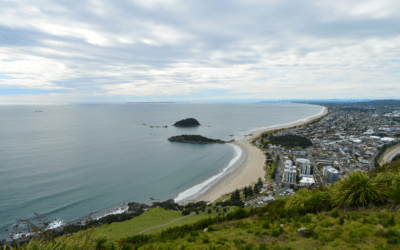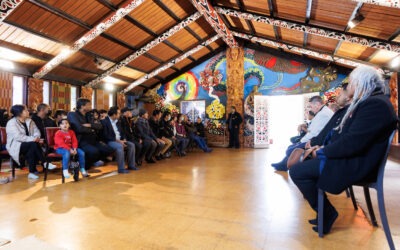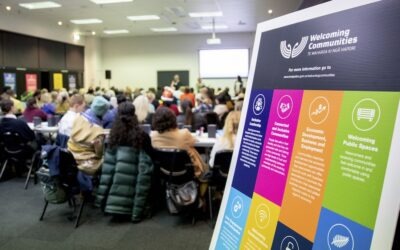June Rout
Welcoming Communities Program Manager, Immigration New Zealand
Q: Can you tell us about your work on the Welcoming Communities program in New Zealand?
A: Welcoming Communities – Te Waharoa ki ngā Hapori – is a settlement program that was started in New Zealand in July 2017. We built on key components from the program and ethos of Welcoming America in the US, and Welcoming Cities in Australia, adapting them to our environment and partnering with tangata whenua to implement Welcoming Communities. Tangata whenua are the indigenous Māori people of Aotearoa New Zealand, including iwi (tribes), hapū (subtribes) and other hapori Māori (Māori communities).
The Standard’s principles acknowledge the important role of tangata whenua as respected leaders and key collaborators in the development and delivery of the program. Two key Māori cultural values underpin the program. They are Whanaungatanga, the importance of relationships, and Manaakitanga, the value of extending hospitality and caring for other people.
Immigration New Zealand supports local government councils and their communities to create a welcoming and inclusive environment for newcomers: recent migrants, former refugees and international students. With the support of our international partners, we have developed a Welcoming Community Standard, and as of December 2019 we have an accreditation process, so that’s really exciting!
Q: Does it make a difference to lead this work from within the national government?
A: As part of the central government, we cannot take an advocacy role or undertake lobbying work in a way that an NGO such as Welcoming Cities can. We do, however, have existing relationships across the public service. We can therefore draw on the expertise of our colleagues in other central government agencies to support the program.
Part of my role is to link the councils’ Welcoming Communities coordinators with relevant central government agencies. So for example, Education New Zealand might work with councils to leverage off their accreditation status to attract international students to their educational facilities.
Being part of a large government agency, I have also access to a large number of colleagues who can help with things like drafting and designing high-quality resources.
Q: How do you see your partnership with Welcoming International impacting your work in New Zealand?
A: It’s important to celebrate and promote the good work that the councils and their communities are doing in welcoming newcomers. Communities around New Zealand are now able to see their work acknowledged. Welcoming International has been a great support with this by showcasing on the global stage some of the work that was happening here.
The advent of Welcoming International has helped for all of us to feel that we are not alone in this work, which can be challenging as well as very rewarding. To both contribute and learn from others is very exciting; we strengthen each-other’s programs and therefore we strengthen the movement. The Welcoming International ethos of non-competitive relationships has been adopted across the councils. If one of the communities produces a really good welcoming pack, for example, everybody gets to see it and take ideas from it. We constantly inspire each other to do better.
Q: How do you support your members?
A: We recognize that it is local councils that understand the complexities, challenges and potentials of their own communities, so municipalities have leadership over the delivery of Welcoming Communities programs in their regions. The standard and the accreditation model were also co-designed with the participating councils and others. With the standard we also sought feedback from all New Zealanders through a country-wide consultation process.
Our role at the center is to support our councils by sharing knowledge and offering networking opportunities. They also receive ‘seed funding’ to employ a dedicated Welcoming Communities Coordinator for three years. Additionally, Immigration New Zealand has Relationship Managers, who are based in the places where the programs are happening, and they support the Welcoming Communities coordinator in that area. Following on from publication of a report on the evaluation of the pilot program, we intend to support councils to increase their ability to monitor and evaluate the impact of the program at the local level.
Q: What are you moving towards?
A: We are supporting communities to become even more welcoming to newcomers to build a competitive advantage to attract, support and retain newcomers. We recognize that welcoming and inclusive activities increase social engagement and grow social inclusion, which in turn build community resilience to respond to significant events such as natural disasters. We have also seen positive outcomes arising from increased levels of trust and engagement between the councils and the newcomers.
Q: Why would the local members want to come onboard the Welcoming Communities program?
A: The program gives councils a framework for being intentionally welcoming and inclusive. The standard encourages them to think through these four questions: What are we doing? Who is doing it? Can we do it better? What else can we do? Many organizations in New Zealand have said to me that they are using the standard and its eight elements to think about what they do and how they do it.
The Welcoming Communities program also gives councils a competitive edge to attract, support and retain newcomers. Anyone can claim that they are welcoming, but involvement in Welcoming Communities makes their welcoming visible and concrete.
From the evaluation findings, we know that program has strengthened relationships across the community, with the councils, and the local iwi. The welcoming activities create many opportunities for locals and newcomers to connect and get to know one another better.
I also think this builds resilience: communities that were involved in Welcoming Communities were well-placed at the time of the March 15 mosque shootings in Christchurch in 2019 to pull the community together. Welcoming America was in the forefront in supporting us as colleagues across the other side of the world and acknowledging our work and it felt like they had our backs. That’s very important.
Q: Are there any local or national successes in your ‘Welcoming’ program that you would like to share?
A: One of the local coordinators said to me ‘welcoming and being inclusive is starting to become business as usual’ and that to me is a major shift in how councils think about what they do. She also said to me that ‘much of what we have been doing is behind-the-scenes; it’s about growing relationships and trust and I can say that newcomers are more confident to connect and engage with the council now’ so to me the shift that she described is very important.
Tauranga City Council, for example, had a fund for community activities which newcomer groups had not accessed. The Welcoming Communities coordinator ran a funding workshop and invited newcomer groups to participate. This helped them see the council as an ally, and it led to newcomers applying for grants from the council for the first time.



